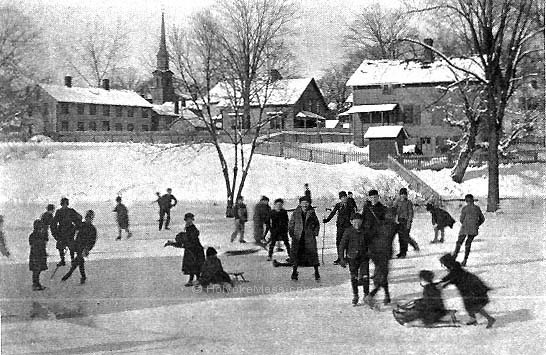On the way back to the village we note the Carew house amidst the shrubs and trees of its low terrace. It is an ordinary, commodious, white-painted, village-house, and its interest lies in the fact of its having been the home of Joseph Carew, a man whose generous public spirit and kindly helpfulness endeared him to the whole community. The street soon begins a steep descent to the wide valley below, which is well filled with the cottages of the villages until you get over to the clay hills which for miles form its eastern boundary. These hills are gashed with diggings where the various brickyards have located. Some of the yards are mammoth establishments, which in the summer are full of life and interest. Lines of carts are continually coming and going between the ragged hills which furnish clay and sand and the machines which grind this crude material and stamp it into bricks. Trucks are plying about the level acres of yard where the bricks are dried, and the oblong blocks of clay are everywhere. Within the sheds a great kiln is building, one is turning, and another of well-baked, red bricks is being torn down and carted off to the Holyoke market. These clay hills rise into a high plain spreading away to the east for many miles — a sandy, scrubbily wooded upland, intermitting with sparsely grated opens. Narrow roadways with lines of turf between the wheel tracks, criss-cross irregularly about, and every now and then you come upon a little house with a bit of garden at its door, and close by, a patch of corn and a field of potatoes. In one place there is quite a village of these little homes, and in the midst a mite of a church. One of the features of the region is a real log house.

Winter.
|
But it is not one of the backwoods variety with a board roof and a rusty stovepipe reaching up through for a chimney, and walls rudely chinked with chips and plaster so that each passing zephyr finds entrance at unstopped cracks. No, it is quite neat and modern, has several L’s and a wide veranda, while a fountain plays in the front yard, very much after the manner of those in the lawns of a city villa. This log house is what you might call civilized, but any kind of log building is scarce enough in our region, so there is plenty of excuse for our turning aside to gaze upon it. Any of the several roads back to the Falls give one fine views of the valley when you come to the verge of the bluff, which, a the south end, almost overhangs the river; and of Holyoke, just across the stream, you get one of the most comprehensive views to be had. The city hall looms up prominently in the midst of the acres and acres of brick mills, and seems to rival Mt. Tom itself, whose massive headland is clearly outlined in the northwest, as guardian of the valley. The views are far reaching and interesting, whichever ravine of the bluff you go down. The "Soap-hill" road is the most direct to the village center. The chief street of the Falls makes a long swinging curve of a mile or so along the line of the river which its residences front, and over which they have a fine outlook, as there are no houses on the water side. a long, gently sloping beach grades down from the road to the water’s edge, dotted here and there with a well-grown tree, and in places starting up to patches of bushes. This affords a good playground for the village children and is a resort in times of flood for those whose wood-piles and replenishing. Whatever can be snatched from the drifting rubbish of the stream is so much gained, and great is the rejoicing if a well-grown log is secured. Between the bridge and the mills above is an acre of two of lowland, where grows a fine grove of tall trees, with smooth gassy meadow beneath. This is a very pretty place, and on days of mellow haze a look through the tree trunks at the big mills makes one think of the great, looming castles, thickset with gables and turrets, of the world across the Atlantic.
|